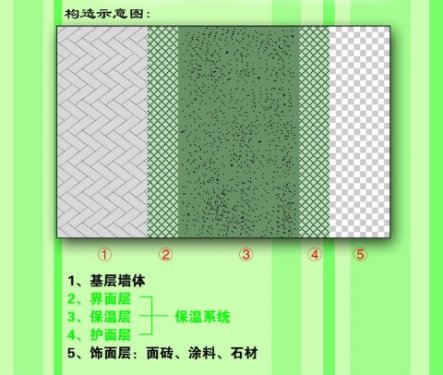 MIT’s Technical Review magazine recently reported that a building material that can absorb heat during the day and release heat at night will reduce the use of air conditioners and will soon be available in the United States.
MIT’s Technical Review magazine recently reported that a building material that can absorb heat during the day and release heat at night will reduce the use of air conditioners and will soon be available in the United States. According to reports, gypsum boards are used on the walls of most buildings. The National Gypsum Corporation of North Carolina, USA, is testing a new type of gypsum board that contains capsules that can passively cool buildings by absorbing heat. These capsules are produced by German chemical giant BASF and can be added to many building products. In Europe, some new construction products have used this new type of capsule material.
This capsule material contains phase change materials, ie, substances that change shape and provide latent heat as the temperature changes. This allows the principle of cooling the house to be the same as the principle that ice absorbs heat to help the beverage cool down when it melts. Each polymer capsule contains solid paraffin that will melt at room temperature so that they can keep the room temperature substantially constant during the day. Paraffin wax works best in cool climates at night, when the capsule cools down at night, releasing heat stored during the day.
Peter Schossig is an engineer at the Fraunhofer Institute in Munich, Germany. His research team developed this capsule in cooperation with BASF. He said that in some countries in Southern Europe, this material can absorb enough calories during the day to save up to 20% of air-conditioning power demand. In northern Europe, the nighttime temperatures are cooler, and buildings using this material may not need air conditioning at all.
This new result helps to promote the "green" trend of the construction industry - using green building materials that can maintain a comfortable indoor temperature without using electricity. According to the U.S. Energy Information Administration, in the United States, buildings consume approximately 70% of the country’s electricity, of which 8% belong to homes and offices. Lightweight building materials are currently widely used in the United States, such as wooden frames and plasterboards. They enable the building to be completed quickly, but these materials do not absorb much heat, so room temperature fluctuates greatly during the day.
Leon Glicksman, a professor of building technology and mechanical engineering at the Massachusetts Institute of Technology, said that phase change materials provide a way to add regenerators to lightweight building materials. Since the 1950s, several companies have tried to develop passive cooling systems that can utilize the characteristics of phase change materials, but they have achieved limited success because it is difficult to add new materials to existing building materials.
BASF obtains microcapsules by rapidly stirring the melted wax with hot water. Because wax and water repel each other, the wax forms many tiny wax droplets in the water. When the researchers added acrylic acid precursors to the wax water mixture, the repulsive forces between the wax and the water caused the acrylic acid precursors to envelop the surface of the wax droplets. The wet mixture thus obtained can be added to the powder of the gypsum board or dried and then added to other building materials such as cement and mortar.
Another chemical giant, DuPont, is also manufacturing phase change materials that are packed into capsules, and it has been added to heat-absorbing plates for sale in Europe. BASF’s strategy is slightly different from that of DuPont: they sell the capsules to other companies to add to building materials, including ceilings, aerated concrete blocks, and plasterboard. A study conducted by BASF estimates that, if Germany's electricity prices and climatic conditions are taken as an example, if 360 g of phase-change material (approximately US$4883) is added to the gypsum used in a residential house, the electricity cost can be saved within 5 years. cover the cost.
The paper wound tape measure is humanely written the length of wound and the patient`s name for medical record.
The measuring ruler has better durability. It gives the doctor a direct visual impression on the wound, so doctor can address it quickly.
About Materials: We have 3 types of paper.
1. Art paper, this material is disposable material which is not waterproof and tearproof2. Synthetic paper, which is waterproof and tear-proof.
3. Tyvek paper, also called Dupont paper, this material is also tearproof and waterproof, and it is sofer and lighter than the Synthetic paper
About Size:
The size of the Paper Tape Measure can be completely customized.
The maximum length that we can make is 160cm/62inch.
The standard width is 20mm. And wider size like 25mm, 30mm is also workable for us.
About Usage:
1. Art paper tape measure is widely used in medical area, such as wound measuring tape. It is disposable and it prevents cross-infection.
Measure in both inches or centimeters on one side, so you can record the units that are most appropriate for each patient visit.
2. Synthetic paper tape measure contains full color custom printing information on both sides.
It is used for multiple purposes such as measuring child height, circumference of furniture, room space calculating, etc. The synthetic paper is strong and resistant to water and tear, it can be used repeatedly.
3. Tyvek paper tape measure is Latex-Free, it prevents reactions in patients with a latex allergy when you use Tyvek paper measuring tapes.
They are made without latex to make it easier to accommodate people with allergies in your office, so you can provide the best level of patient care.
Hospital Paper Tape Measure,Pregnant Dupont Paper,Medical Disposable Tape Measure
Wintape Measuring Tape Company , https://www.wintapetapemeasure.com